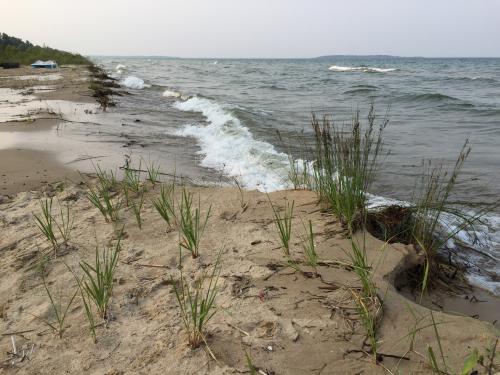Protecting Your Great Lakes Waterfront Investment
Keeping shoreline landscapes natural saves time, money.

If you live or vacation along Michigan’s Great Lakes shoreline, you know just how privileged you are. This amazing coastline – more than 3,000 miles – provides outstanding scenery, diverse shoreline habitats, and recreational access to one of the world’s greatest freshwater seas. Living in Michigan affords opportunities to both recreate and enjoy home ownership along these dynamic coastlines.
If you are a coastal landowner, have you thought about your environmental stewardship role and responsibility for these habitats? Consider also the economic value of protecting these unique and diverse habitats.
Great Lakes water levels are cyclical and will fluctuate daily, seasonally, and annually; expect to be flexible to these changes. Common sense approaches in addressing issues caused by water level change can save you time and money, enhance surrounding natural areas, and may be easier than you imagine.
An Ecologically Valuable Coastline
Recognize your coastal property abuts a significant public resource – the Great Lakes. Michigan’s coastline is as diverse as it is long in miles. Sandy beaches and ranging dunes are 
Coastal wetlands represent some of the most productive and biologically diverse ecosystems in the Great Lakes. These are reflected in breeding, nesting, and feeding areas for a wide array of native and migratory birds, nursery areas for many Great Lakes fishes, and a diversity of smaller organisms providing food and nutrient cycling roles in these ecosystems. Resource stewardship of these ecologically valuable coastal habitats also functions to protect and even enhance one’s waterfront investment.
Benefits of Resource Stewardship
In Michigan, energetic coastal processes of the Great Lakes ensure ever-changing shorelines due to currents, winds, waves, and changing water levels. Perhaps coastal erosion with high water levels or emergent beach vegetation with low water levels has weighed in your decisions about building location and management of your coastal property.
Protecting shoreline habitats enhances wildlife-watching opportunities, and natural scenic shorelines can add value in marketing to homebuyers and tourists looking for that perfect beachfront getaway. Scenery and ecosystem value not enough? Coastal wetlands provide water quality values serving as a pollution “filter” and can greatly reduce risk of costly damage from storms, wind and waves. Vegetation serves to absorb wind and wave energy while root systems hold sand, slowing erosion. For property value, preventing sand from eroding away from your waterfront is good – keeping your house from eroding into the lake is even better.
Stewardship Opportunities for Shoreline Property Owners:
“Along the Shore: A Shoreline Management Guide for Michigan Coastal Landowners” is a free publication available online from Michigan Sea Grant and offers the following guidance for shoreline property owners:
- To ensure the greatest long-term benefits, allow shoreline vegetation to remain untouched as much as possible.
- Limit the frequency of mowing (no more than twice a season) and leave vegetation at a height of 20 inches or more to preserve maximum habitat value. The presence of birds and other wildlife attracted by the richer habitat will also enhance your view!
- With the proper permit, remove invasive plants such as Phragmites or purple loosestrife by hand and dispose of by burning or bagging and landfilling. Do not mow invasive plants, as this creates fragments that can multiply and spread.
- To access the water’s edge, consider a narrow path to minimize the impacts of habitat fragmentation — no more than 6-feet wide, composed of sand.
Stewardship of coastal natural areas will pay off in enhancing value in your property investments. Your natural shoreline will be more stable making your home better protected against the elements of a dynamic coastline. Habitats will be enhanced and flourishing with wildlife. Your stewardship actions can enhance scenery value and marketability of your coastal properties, while maintaining options for easily accessing the coastline you seek to enjoy. Regardless of your management decisions, secure appropriate permits before beginning any management activities or work.
Michigan Sea Grant helps to foster economic growth and protect Michigan’s coastal, Great Lakes resources through education, research and outreach. A collaborative effort of the University of Michigan and Michigan State University, Michigan Sea Grant is part of the NOAA-National Sea Grant network of 33 university-based programs.



 Print
Print Email
Email


